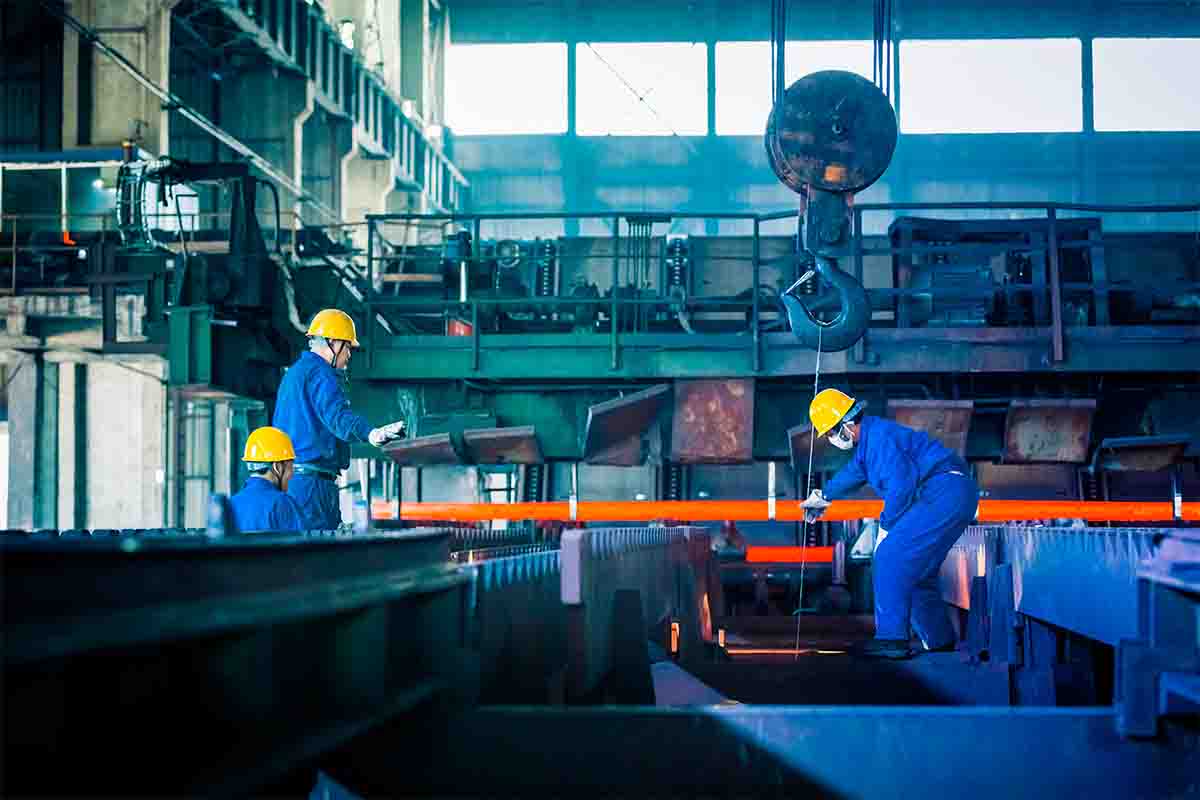Safety Talk About Pinch Points

Every day we go to work, and we rely on the equipment around us to do our jobs safely. But sometimes, that equipment can be dangerous, especially if we don’t know how to use it properly. This talk is about one particular type of danger: pinch points.
First of all, what is a pinch point? A pinch point is a place where two pieces of machinery meet, and if you get your body caught in between them, you can be seriously injured.
The phrase “pieces of machinery” could mean anything from the gears in a car engine to the blades on a lawn mower. Basically, anything that has moving parts.
Beware of pinch points. Your safety is in your hands.
According to the U.S. Bureau of Labor Statistics:
- In 2018, 58 percent of amputations (3,580 cases) involved some type of machinery
- There are 110,000 lost time cases due to hand injuries annually

Why is pinch point safety important?
When machines are in use, there is always the potential for something to go wrong. That’s why it’s important for employees to know about pinch points and how to stay safe around them. By knowing what to watch out for, employees can help keep themselves and their coworkers safe while working.
Pinch points can be found on many different types of machinery, including conveyor belts, power presses, and rollers. They can also be found in other places, such as doors and gates. Sometimes, pinch points are hard to see because they’re hidden by other parts of the machine or because they’re small. That’s why it’s important for employees to be aware of their surroundings and know where the pinch points are on the machines they’re using.
If an employee is working near a pinch point, there are a few things they can do to stay safe. First, they should make sure that their clothing and hair are away from the moving parts of the machine. They should also stay alert and be ready to stop if something goes wrong. If an employee sees someone else in danger of being caught in a pinch point, they should warn them and help them get to safety.
Pinch points are just one of many dangers that can be found in the workplace. By being aware of them, you can stay safe.
OSHA regulations for pinch points
One of the key functions of the Occupational Safety and Health Administration (OSHA) is to protect workers from potential hazards in the workplace. This includes ensuring that employers take steps to identify and mitigate any potential pinch points in their facilities.
A pinch point is a specific area in a machine or process where an employee could be injured if they were to come into contact with it. OSHA has specific regulations in place to ensure that employers identify and mitigate these hazards.
The following are the relevant OSHA regulations relating to pinch points:
Pinch points hazards
Pinch points are a common hazard in many workplaces. Here are some examples:
- Injuries can occur when someone reaches into or through the opening, and their hand or arm is pinched.
- A pulley system becomes jammed. The operator hoists to force the pulley. A person attempts to unjam the chain. The pulley is freed, and the worker gets trapped between the pulley and the moving chain.
- To ensure smooth operation, a worker reaches into a machine to remove a build-up of waste materials. They misjudge the clearance while they cannot see their hand, and their finger is caught between the rotating shafts.
- A worker has decided to dispose of heavy objects in a dumpster. His finger is caught between the dumpster’s edge and the object as he drops it in.
- The driver of a shovel loader does not see a colleague below and pins them to a piece of machinery with the bucket by accident.

Pinch points toolbox talk
A pinch point is an area on a tool where two fingers can be pinched together. This can cause a serious injury if your fingers are caught in the pinch point. Be sure to avoid these areas when using tools.
Some common pinch points include:
- The area between the blade and handle of a knife
- The space between the jaws of a pair of pliers
- The gap between the teeth of a saw blade
Be sure to keep your fingers away from these areas when using tools. If you are not sure how to use a tool safely, ask someone for help.
Many times, pinch-point injuries result from workers who don’t know the dangers of machinery or who take shortcuts to speed up the process but injure themselves instead. Do not attempt to perform a task without proper training.
Pinch-point injuries can often happen when machines are temporarily stopped for cleaning or service.
When workers can observe guard policies while the machine is being used, it is important that they follow the lockout and tagout (LOTO) procedures when the machine is stopped.
However, workers are not safe if the equipment has not been switched off.
Here’s how to prevent pinch-point injuries:
- Learn about the dangers and safety procedures to work safely every day.
- Conduct frequent, targeted inspections to make sure guards are present and that procedures are being followed.
- Reward employees who identify and report hazards quickly and help to resolve them
One common way to mitigate pinch points is by installing guards or barriers around them. This can help to prevent employees from coming into contact with them and can also help to deflect any debris or objects that may be ejected from the point.
Employers should also ensure that employees are properly trained on how to safely work around pinch points. This includes knowing where they are in the facility and what steps they need to take to avoid them.
There are a number of illnesses and injuries that can be related to pinch points. Pinch points can cause cuts, scrapes, and bruises. In more severe cases, they can lead to amputations or even death. It is important to be aware of the dangers of pinch points and to take steps to avoid them.
Some simple tips to avoid pinch points include:
- using gloves when working with machinery or tools
- avoiding loose clothing or jewelry that can get caught in machinery
- being aware of your surroundings and keeping clear of areas where pinch points might be present.
If you do experience an injury from a pinch point, it is important to seek medical attention immediately. In some cases, surgery may be required to repair the damage.
Questions to employees
- What is a pinch point?
- How can you identify a pinch point?
- What are some common pinch points in a process?
- How can you prevent or mitigate pinch points?
- What are the consequences of a pinch point?
Promote pinch point safety with this email template
Hi [Name],
I wanted to reach out and discuss hand safety pinch points with you. A recent study found that a high percentage of injuries in the workplace are due to hand pinch points. In order to avoid these types of injuries, it’s important to be aware of the pinch points in your work area and take measures to avoid them.
Some tips to avoid hand pinch points include:
- Being aware of your surroundings and where the pinch points are
- Keeping your hands and fingers away from pinch-point areas
- Using appropriate tools and equipment that reduce the risk of hand pinch points
- Making sure machine guards are in place and working properly
If you have any questions or concerns about hand safety pinch points, please don’t hesitate to contact me. I’m happy to discuss this further with you.
Thank you,
[Your Name]
Video on pinch points
Pinch points meme
Conclusion
Hand safety is important in all workplaces, but it’s especially crucial in industrial and construction settings. Many injuries occur when workers are pinched by moving parts or machinery. Remember, hand safety should be a top priority in any workplace. Follow the tips in this article to help keep your hands safe and healthy.
Industry specific pointers for Pinch Points
Understanding the Risks of Pinch Points in Robotics and Automation
As industries continue to rely on robotics and automation, pinch points have become more prevalent. Robots and automated machinery have become essential in improving efficiency and reducing human error, but they can also pose significant risks if not adequately managed. It’s crucial for industry experts to understand these risks and implement appropriate safety measures to protect employees from pinch point injuries.
Some common risks associated with robotics and automation include:
- Human-robot interaction: When humans work alongside robots, they may inadvertently enter the robot’s workspace, leading to pinch point injuries.
- Maintenance and repair: Maintenance and repair activities often require workers to access moving parts of machinery, creating potential pinch points.
- System failure: In the event of a system failure, a sudden or unexpected movement of the robotic arm or machine part may lead to pinch point injuries.
To mitigate these risks, consider implementing the following strategies:
- Define work zones: Establish clearly marked work zones for both humans and robots to minimize the likelihood of human-robot interaction.
- Establish lockout/tagout procedures: Implement strict lockout/tagout procedures to ensure that machinery is fully powered down before maintenance or repair work begins.
- Invest in safety technology: Consider using safety sensors, light curtains, or other safety technology to detect when a worker enters a hazardous area and automatically shut down the machinery.
Employee Training and Awareness
Effective employee training and awareness campaigns are critical in reducing pinch point injuries. All employees should be trained to recognize pinch points, understand the risks, and know how to avoid them. This can be achieved through:
- Regular safety meetings: Hold regular safety meetings and toolbox talks to discuss pinch points and other potential hazards in the workplace.
- Visual aids: Use signs, posters, and other visual aids to remind employees of the dangers of pinch points and the importance of staying vigilant.
- Encourage reporting: Create a culture that encourages employees to report any hazards they encounter and provide them with the necessary tools and resources to do so.
Managing Pinch Points in the Supply Chain
Pinch points can also occur in supply chain operations, such as forklifts, pallet jacks, and other material handling equipment. To manage pinch points in the supply chain, consider the following best practices:
- Use the right equipment: Ensure that all material handling equipment is appropriate for the task and meets necessary safety standards.
- Train operators: Provide comprehensive training for all operators, including awareness of potential pinch points and strategies to avoid them.
- Maintain equipment: Regularly inspect and maintain material handling equipment to minimize the risk of pinch points due to malfunction or wear.
By implementing these strategies and continuously promoting a culture of safety, you can help reduce the risk of pinch point injuries in your workplace. Remember, prevention is the key to maintaining a safe and productive work environment for all employees.

